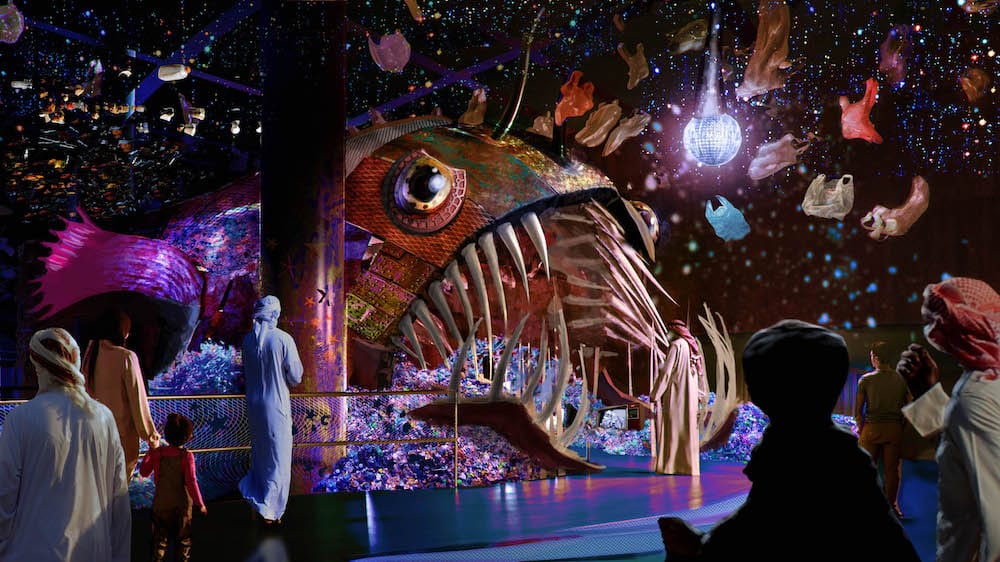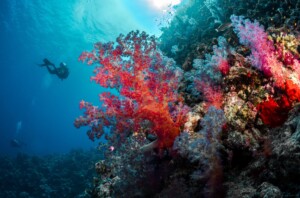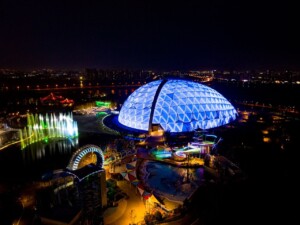Sustainability is more than just a buzzword. As we face the challenges of climate change, everyone must do their bit to limit their impact on the environment. In recent years, we have seen more sustainable projects than ever before in the attractions industry, from carbon-neutral resorts and cutting-edge new developments to green museums.
Sustainable museums: join the conversation
In recent years, blooloop has explored sustainability in the museum sector and the wider attractions industry in its yearly greenloop conference.
In 2023, speakers from the world of museums included Andrew Anderson of The Shakespeare Birthplace Trust, Ibrahim Tchan of Ecomusée Tata Somba, Sarah Sutton of Environment and Culture Partners, Patrick Hamilton from the Science Museum of Minnesota. We also had speakers from the Eden Project, Meow Wolf, Merlin Entertainments and more.
Attendees heard from leading climate scientist Professor Tim Lenton of Exeter University, who explained why it’s not too late to avoid climate catastrophe, but we need to act quickly to trigger positive tipping points. Meanwhile, Prof Colin Davis, Chair in Cognitive Psychology at the University of Bristol, told us how to communicate to avoid climate apathy.
Design, outreach and more
One key way that museums can show they are sustainable is by ensuring that their buildings are environmentally friendly. The common measure for this is the Leadership in Energy and Environmental Design (LEED) certification.
Organisations wanting to obtain this certification can earn points for various green building strategies. Venues can earn one of four LEED rating levels: Certified, Silver, Gold or Platinum. Doing this is a big step for some museums, as they often require strict conservation conditions to protect their collections. This can use a lot of energy.
As well as sustainable building design, museums also play a role in climate change education and outreach projects. They can highlight key issues and thus inspire their communities to make a change for the better.
See also: Environment & Culture Partners: collaboration is key to climate change action
17 sustainable museums from around the world
The Smithsonian National Museum of the American Indian, Washington D.C., USA

The mission of the National Museum of the American Indian, in partnership with Native peoples and their allies, is to foster a richer shared human experience through an understanding of Native peoples. Native peoples have a rich history of respecting and protecting the environment. Therefore, sustainability is a key issue for this museum.
The building was awarded the US Green Building Council’s LEED silver rating in 2011. Then, in 2016, it was recertified at the gold level.
Maintaining certification is one way the museum can hold itself accountable. However, it has also launched a project, in collaboration with four Native communities, which documents how they are responding to environmental challenges. This aims to help people learn about the environmental issues that American Indians face today.
See also: The First Americans Museum: one place, many nations
The Field Museum, Chicago, USA
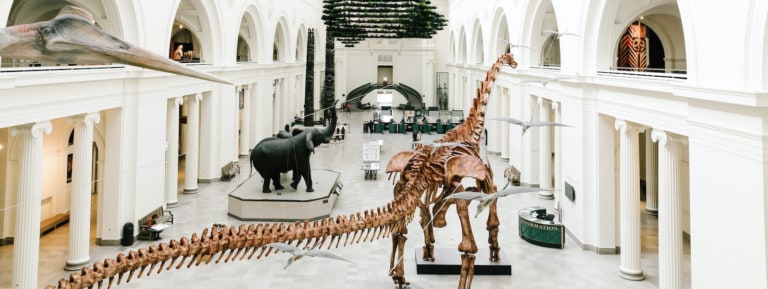
Chicago’s Field Museum has been at the forefront of museum sustainability for decades, having first established a ‘Green Team’ in 1989, called A Greener Field. This brings together more than 40 members of staff from across the museum, who are working to improve the organisation’s sustainability.
This team meets once a month to share ideas and successes and helps to integrate environmentalism, conservation, and sustainability into the museum’s operations. One of the most successful projects to date is the museum’s Edible Treasures Garden. This is an organic vegetable garden that explores how to garden in an urban setting.
In 2015, the Field Museum also received gold LEED certification for Existing Buildings: Operations and Maintenance.
The California Academy of Sciences, San Francisco, USA
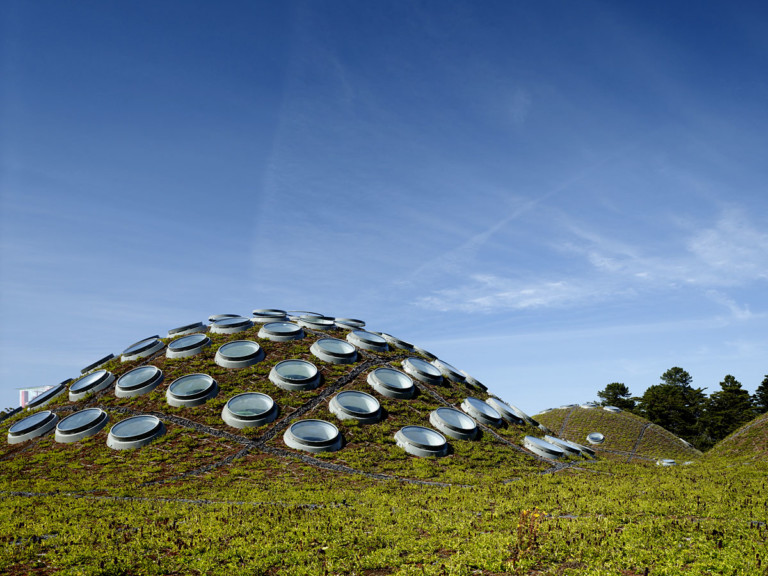
The California Academy of Sciences has platinum LEED certification and says it is on a mission to be the greenest museum in the world. The museum building, designed by Renzo Piano, opened to the public in 2008. It has many different sustainable features, from its 2.5-acre Living Roof to its cutting-edge basement.
The Living Roof, which is also surrounded by solar panels, catches excess stormwater, provides insulation to reduce energy consumption and transforms carbon dioxide into oxygen. It is home to around 1.7 million plants, making it a haven for birds, insects and more.
In addition to this, the Academy works to raise awareness about biodiversity. It is part of several conservation initiatives, including a breeding program for endangered African penguins.
Ike Kwon, who oversees infrastructure, guest and building operations at the California Academy of Sciences, was named in the blooloop 50 Museum Influencers list 2021.
In 2022, California Academy of Sciences entered Wander Woods, a hands-on, nature play and exploration space, into the blooloop Innovation Awards. Constructed from locally sourced materials like salvaged tree trunks, Wander Woods features accessible spaces that give visitors an immersive way to explore nature.
- Wander Woods has been designated an official “Nature Exploration Area” by San Francisco Children and Nature, in recognition of its ability to connect young people with the natural world
The Prado Museum, Madrid, Spain
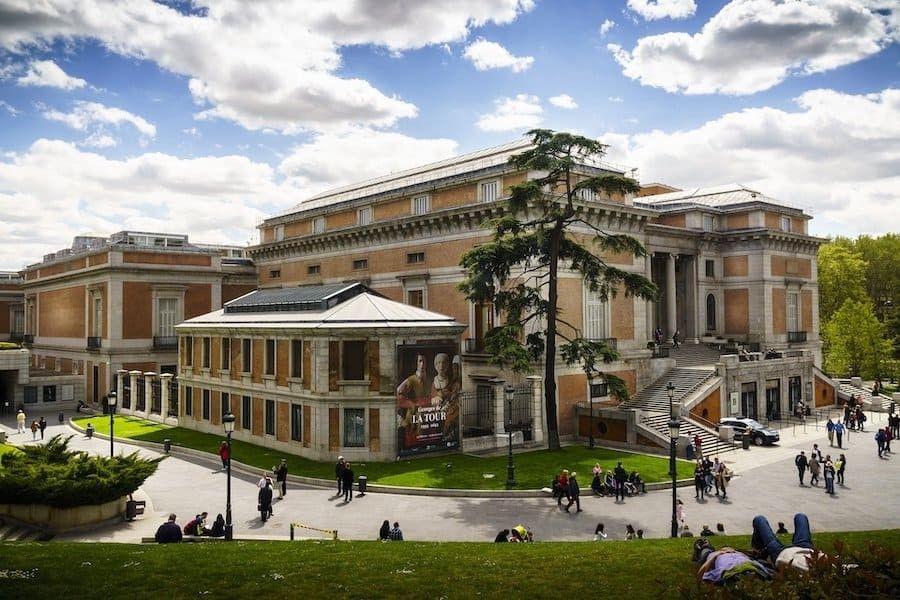
The California Academy of Science was able to meet its sustainability goals by building a new museum from scratch. However, this is not always possible for heritage buildings. But refurbishment projects can be a chance to introduce more environmentally-friendly design, as Spain’s Prado Museum shows.
In 2015, the museum worked with the Fundación Iberdrola to implement a new, more sustainable LED lighting system. This resulted in an annual energy saving of 75% and also cut its emissions by 320 tons of CO2 each year.
Furthermore, the Prado Museum has also worked on projects to raise awareness of climate change. In 2019, it partnered with the World Wildlife Fund (WWF), digitally altering four well-known works of art from its collection. These were updated to show the impact of a 1.5% increase in the global temperature.
The Prado Museum began showcasing a selection of its artworks in Shanghai’s Longhua metro station in December 2021, with the pop-up running through February 2022.
In 2022, Javier Sainz de los Terreros, the museum’s digital communication manager, spoke to blooloop about his unique approach to connecting with a global audience.
The Museum of Tomorrow, Rio de Janeiro, Brazil

The Museu do Amanhã (Museum of Tomorrow) opened in 2015 and was designed with sustainability at the forefront. It features solar panels that move with the sun as well as an air conditioning system that uses water from nearby Guanabara Bay, cleaning it and returning it to its source in the process. It also collects and reuses rainwater. The museum saves around 9.6 million litres of water and 2,400 megawatt-hours of electricity per year.
As well as the sustainable design, the museum’s content is primarily concerned with environmental issues too. Exhibits focus on the urgent need for change, as Hugo Barreto, the head director of content, explained in an interview with the Guardian ahead of its grand opening:
“When people think of the ‘Future’, it usually seems very far away. That’s why we called the museum ‘Tomorrow’. It’s closer. It depends on what we do today,” he said.
The attraction has influenced other new museums, including Dubai’s Museum of the Future, as Lath Carlson explained to blooloop in 2023.
The Museum of Liverpool, Liverpool, UK
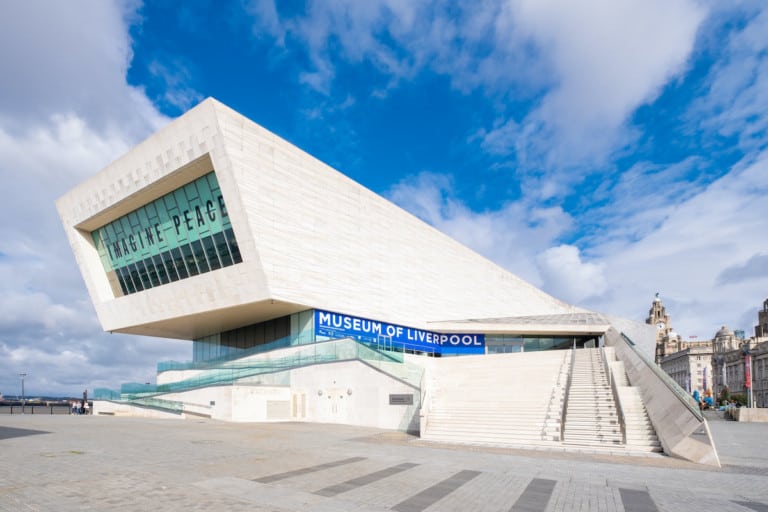
When it opened in 2011, the Museum of Liverpool, located on the city’s UNESCO World Heritage waterfront, marked a new chapter in sustainable building projects.
The design features an energy-efficient ‘trigeneration’ plant – a combined heat and power system that efficiently generates heat, cooling and electricity, reducing CO2 emissions by 884 tonnes per year. A mix of low carbon fuels and renewable energy powers this plant.
Furthermore, National Museums Liverpool is one of many organisations around the world to have declared a climate and ecological emergency. In a 2019 statement, Laura Pye, Director of National Museums Liverpool said:
“For many of the communities, artists and experts we work with, along with our staff and visitors, this is an emergency on an unprecedented scale and we must not only shine a light on their concerns but also rigorously examine our own practice.”
National Museums Liverpool has also announced plans for the continued development of the area around the docks, including the expansion of the International Slavery Museum.
National Museums Liverpool recently collaborated with artist and sculptor Wolfgang Buttress to create an immersive new exhibition called Bees: a story of survival. This takes guests on a journey into the lives of bees and explores their relationship both with humans and with the natural world around us.
Ningbo History Museum, Ningbo, China
The Ningbo History Museum features a unique design, created by the 2012 Pritzker Prize-winning architect, Wang Shu. The building itself is constructed out of the rubble left over from demolition sites around the province and was built using traditional techniques. The idea was to use the materials that were already available, in an efficient way, as well as making a statement on the country’s modern habit of demolition and reconstruction.
This museum, which resembles an upside-down mountain, explores the art and culture of China’s Ningbo region.
Jeongok Prehistory Museum, Yeoncheon, South Korea

The Jeongok Prehistory Museum in Korea, designed by the French architecture firm X-TU, is another museum built with sustainability in mind. The building, which opened in 2011, includes a double wall for energy efficiency. It is also made of light-reflecting material, allowing the museum to maintain a stable interior climate.
It is located on a significant palaeolithic site, where the first Acheulian hand axe was discovered in East Asia. The museum might look shiny and space-age, but speaking about the design, the architects’ website says:
“The structure seeks to harmoniously co-exist with the natural surroundings, physically acting as a threshold between modern-day and archaic times. The soft and rounded form meanders around the site, paying homage to the watery landscape that originally existed nearby.”
Image courtesy of X-TU architects
The Exploratorium, San Francisco, USA
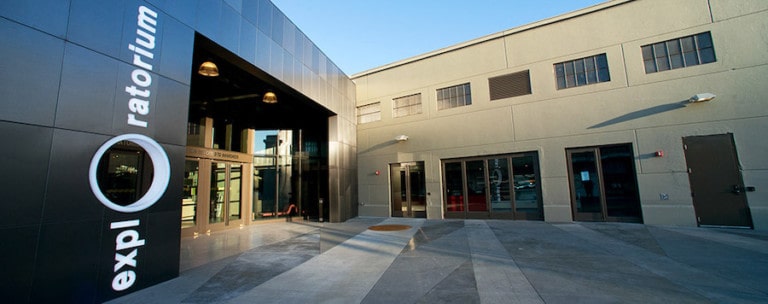
The Exploratorium aims to become one of the first and largest zero net energy museums in the world. Part of this project included the renovation and preservation of a historic building at San Francisco’s Pier 15, using recycled materials. Now, the building is platinum LEED-certified.
The museum’s rooftop includes solar panels, generating around 2,000 MWh of clean energy each year. Thanks to this, as well as its energy-efficient design, the museum says it produced 76% of its energy needs on-site in 2018.
In addition, The Exploratorium also works to educate visitors about the realities of climate change.
Elsewhere in San Francisco, The Institute of Contemporary Art is a new museum designed to be more equitable and socially aware than traditional art galleries and museums.
Grand Rapids Art Museum, Grand Rapids, USA
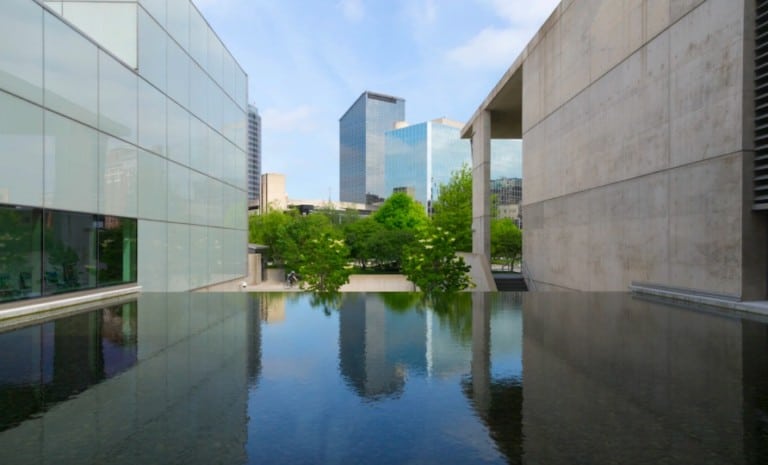
Located in Grand Rapids, Michigan, named “America’s Greenest City” by Fast Company magazine, Grand Rapids Art Museum was the first art museum in the world to receive gold LEED certification, in 2008.
The building includes several sustainable technologies, such as a high-efficiency HVAC (heating, ventilation, and air conditioning) system. 20% of the building materials are recycled, and the design ensures that the art museum can get 70% of its light from natural sources. It also has a rain and greywater reuse system that cuts water consumption by 20%
The Natural History Museum, London, UK

London’s Natural History Museum has pledged to become the first museum in the world to set a science-based carbon reduction target. It also says that being sustainable is a key driver in its decision-making process. On its website, a statement reads:
“We aren’t perfect, but we’re looking at ways we can reduce the Museum’s carbon emissions and energy consumption, reuse and repurpose technology, and encourage everyone to refill and recycle.”
Like National Museums Liverpool, NHM also declared a planetary emergency in 2020. Later the same year, it announced Our Broken Planet: How We Got Here and Ways To Fix It. This was a year-long season of events looking at climate change and biodiversity.
The museum staged free evolving display across the year. These opened in three stages, each exploring one of three themes: food, resources and fossil fuels.
In 2021, the NHM was also involved in several events at COP26 in Glasgow, in line with its new strategy of creating advocates for the planet. In 2022, it began work on the redevelopment of its gardens as part of the Urban Nature Project. This will se its grounds being transformed into an accessible green space and biodiversity hub in the middle of London.
The Climate Museum, New York, USA

One way of ensuring that your museum building has a sustainable design? Don’t have a permanent building at all. New York’s Climate Museum is on a mission to inspire action on the climate crisis and holds temporary exhibitions, pop-ups and events that explore the topic. The initiative was born in the wake of Hurricane Sandy.
Previous exhibitions include Taking Action, which presented hands-on learning about climate change solutions. This took inspiration from the youth climate movement and was mainly staffed by high school students.
The Climate Museum also hosts a discussion series, Talking Climate, on the second Friday of each month.
In 2023, founder Miranda Massie spoke to blooloop about the Climate Museum’s ethos, and its pop-up location in New York City.
Natural History Museum of Utah, Salt Lake City, USA

The Natural History Museum of Utah in Salt Lake City moved to a brand new building in 2011 which has LEED gold certification. The museum’s new home, the Rio Tinto Center, was designed by Ennead Architects and GSBS Architects with sustainable credentials in mind.
The museum holds over 1.2 million objects, over a site of 163,000 square feet. Features include almost 1,400 solar panels, which provide over a quarter of the museum’s energy needs. Rainwater is also collected from the roof to irrigate the entire site.
During the construction process, over 75% of the waste generated was recycled. This includes wood, metal, concrete, plastic and cardboard, as well as office supplies. In addition, the project restored surrounding areas to their natural state after construction, replanting native vegetation.
Image credit Tom Smart
Cité de l’Océan et du Surf, Biarritz, France
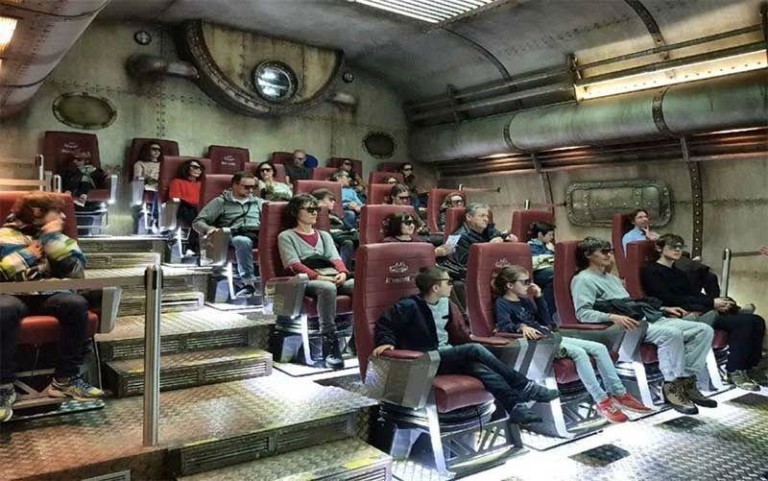
Perched next to the sea in Biarritz, the Cité de l’Océan et du Surf explores surf and the ocean, as well as their impact on people’s leisure, science, and ecology. The design, by Steven Holl and Solange Fabião, echoes the nearby ocean and beach. It also features a garden with local vegetation.
One recent exhibition allowed visitors to experience the Arctic landscape and its wildlife through an immersive 4D experience. A 5 minute-long Arctic 4D film features unique Arctic landscapes and the rare and endangered species call this region home.
Terra – The Sustainability Pavilion, Dubai, UAE

While not technically a museum, Terra, the Sustainability Pavilion, (pictured, top) helped visitors to explore ecology, sustainable technologies and design through the use of immersive experiences and exhibits. It played a key role at Expo 2020 Dubai.
Speaking about Terra’s role in educating and inspiring people in an earlier interview with blooloop, its Director John Bull said:
“Every single person can make a difference. There are small things that each one of us can do in our lives that will genuinely make an impact. But what we also need to know is that we shouldn’t feel disempowered, we should feel that we have agency.
“We also have agency by coming together. These big issues do need tackling on a bigger scale, but what are governments? They are representatives of the people. Expo 2020 Dubai is about bringing people together, to discuss things, to find ways forward. If we can do that, and speak with one voice to suggest a new way forward, there really is hope.”
The key themes of Expo 2020 Dubai were sustainability, mobility and opportunity.
Boston Children’s Museum, Boston, USA

Boston Children’s Museum is a sustainable museum both in design and in content. The building itself is LEED gold certified, with features such as stormwater reclamation, efficient lighting, real-time heating and cooling, and green housekeeping.
It also has a 6,400-square-foot green roof covered with plants and organic materials which helps to insulate the building. Furthermore, the green roof collects rainwater and reduces air pollution.
Content-wise, the museum in Boston also explains these sustainable design features to young visitors throughout the venue, with its Green Trail. As well as explaining how these elements work, each station on the trail also suggests some ways that people can make their own houses and communities greener.
MuSe, Trento, Italy
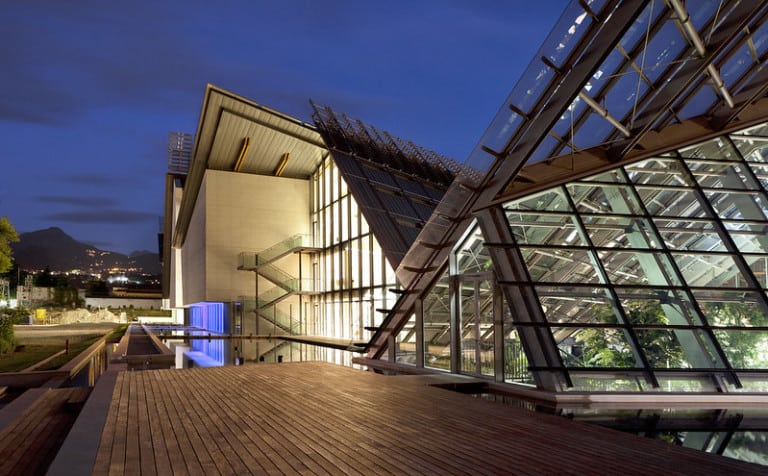
This Italian science museum is another LEED gold-certified sustainable venue. It opened in 2013 and uses cutting-edge technology to minimise its impact on the environment.
Designed by Renzo Piano, it uses a range of renewable energy sources including solar power. In addition, design elements like windows, wall thickness and blinds maximise the building’s energy performance. It also reuses rainwater for the toilets, the greenhouse and the aquarium.
Locally sourced materials were used where possible to minimise pollution from transport. Plus, the museum encourages visitors to consider their journey. There are limited car parking spaces and the museum is easily accessible by bicycle or by public transport.
Image credit Paolo Riolzi
